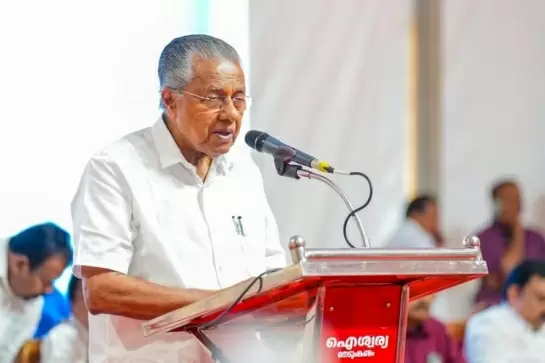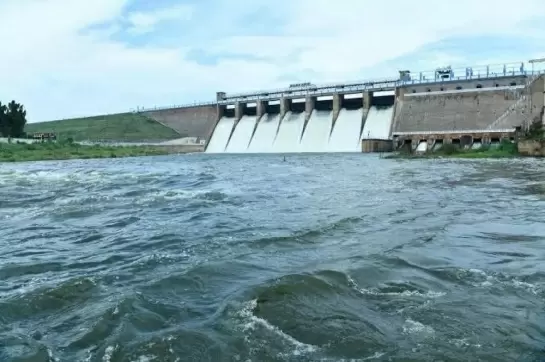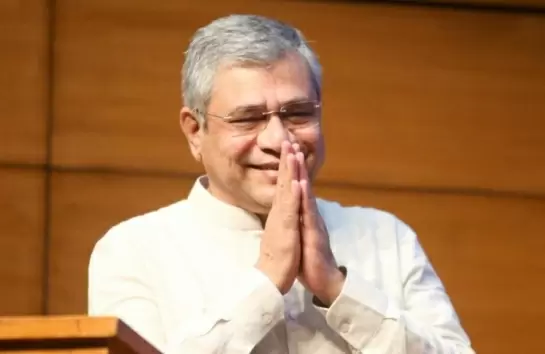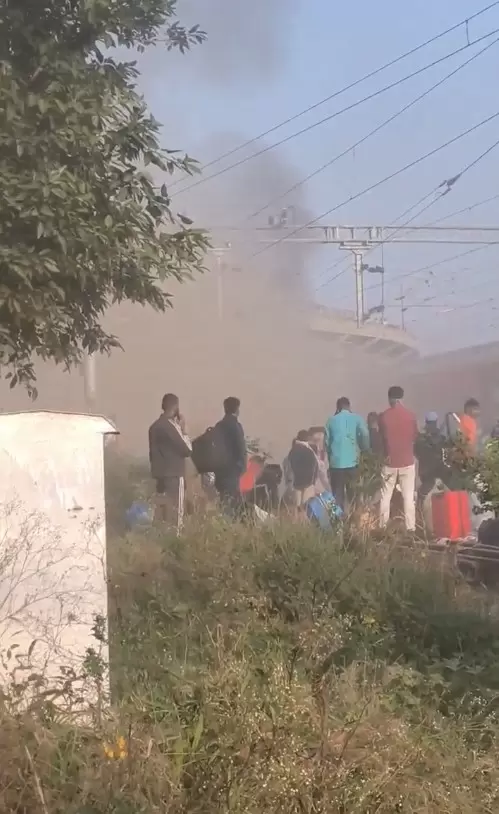Historically and demographically, Peermedu and Devikulam taluks belong to TN
06-January-2012
Vol 3 | Issue 1
The latest attempt by Kerala to deprive Tamil Nadu of its rightful share of waters from the Mullaiperiyar dam using the customary tools – court cases, inciting protests, assaulting Tamils in Kerala, creating a false scare through media and so on – has, for the first time in over three decades of the dispute's history, awakened the people of Tamil Nadu and resurrected an old grievance; that Tamil Nadu was not given Peermedu and Devikulam taluks of Idukki district during the reorganisation of states in 1956.
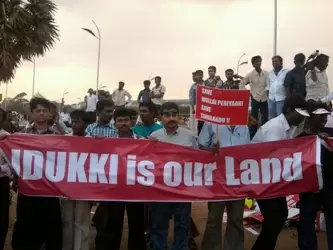 |
|
Youth holding a banner claiming Idukki at the recent rally organised by the May 17 Movement in Chennai
|
The demand that Idukki district be now acceded to Tamil Nadu has been articulated by many people, including politicians and activists, through different forms of protests across Tamil Nadu in the last two months. Political parties such as MDMK, PMK and VCK have voiced the demand and posters seeking retrieval of Tamil areas of Idukki district had also appeared in some places.
With people in urban areas too joining hands to thwart Kerala's game plan to illegally wrest the 8000-acre land on which the Mullaiperiyar dam stands, the talk about retrieving Tamil dominated taluks of Idukki district is not confined to the border districts any longer.
A case in point is the massive turnout at a rally to ‘save the Mullaiperiyar dam’ organized in Chennai last month by the ‘May 17 Movement’, a pro-Tamil organization having support among Tamil intelligentsia including those working in IT industries.
So, even if things are moving in favour of Tamil Nadu on the legal front, the people, who are angered by unsavoury developments like the attack on Sabarimala pilgrims, the abuse of Tamil women there, and Kerala's persistence in spreading the falsehood over the safety of the dam, expect Idukki district, or at least its two taluks of Devikulam and Peermedu that have a dominant population of Tamils, to be handed over to Tamil Nadu.
Not only do people feel that such a move will put an end to the Mullaiperiyar controversy forever, – which has been erupting periodically – but they turn the pages of history to justify such a demand.
Historically, the western territory of ancient Thamilagam, which included the present state of Kerala, was once part of Chera kingdom, one of the three Tamil kingdoms. After the fall of Chera dynasty, several small rulers reigned over the area.
Towards the end of 12th century AD, Poonjar Kingdom came into existence in the area that included the present day Peermedu taluk and the areas adjoining Gudalur in Tamil Nadu.
The Poonjar kingdom (Poonaiyar Thambiran Arasu, in Tamil) was admittedly a Tamil kingdom established by a Tamil king by name Kulasekaran whose father, a Pandian king by name Manavikrama was forced to flee from Madurai, the capital of Pandian kingdom, when it was captured by Cholas.
The Poonjar kingdom held interrupted sovereignty over the area, which consisted of present day Peermedu, Devikulam and Udumbanchola taluks of Idduki district and at times extended to present day Cumbam, Uthamapalayam, Bodi taluks and their surrounding areas, for centuries until the end of 19th Century.
A considerable portion of the catchment area of the Mullaiperiyar and also the area which is under the possession of Tamil Nadu after the agreement of 1886 – where the water is being accumulated and the dam is standing - falls in the Peermedu taluk.
Kerala government has acknowledged in its official website that major portions of present day Idukki district of Kerala had been under the sovereignty of Poonjar Kingdom in the 16th Century.
The Travancore kingdom, the predecessor of the state of Kerala - which shifted its capital from Pathmanabapuram (in Tamil Nadu) to Thiruvananthapuram in 1756 - gained control over a part of the land under Poonjar kingdom only in 1866, when the kings of Poonjar and Travancore entered into an agreement.
As per the agreement, Travancore was to perpetually supply 2000 paras of paddy a year to the family of the former ruler to take control of the region then called ‘Cardamom Hills,’ where paddy cannot be cultivated and rice was a precious food in scarcity.
So, the Travancore kingdom acquired the territory only just 20 years before it signed the 1886 agreement with the Madras Presidency. This agreement gave possession of 8000 acres of land on lease to the Madras Presidency to hold the water and to build a dam to divert the water of westbound Mullaiperiyar into the area under its control.
Archives reveal that the Travancore kingdom begged the Madras Presidency to consider an outright purchase of the land for Rs 6,00,000, but the Madras Presidency did not accede to the proposal.
It is now being alleged that this agreement had been enforced on the Travancore Kingdom, when the truth is that it was this agreement with the British that gave legitimacy to the sovereignty of the Travancore Kingdom over the area.
It is also to be noted that the Governor General of Madras Presidency advised the Travancore state to promulgate its sovereignty over the area under the sovereign control of Poonjar kingdom. Only after that the Travancore kingdom issued proclamation of its sovereignty over the territory of Poonjar kingdom on 24.9.1899 after an agreement with the rulers of Poonjar kingdom.
Thus, historically, the sovereignty of the territory rested with the Tamil kingdoms until the end of 19th century. The sovereignty of Travancore over the area was just for the period of over 50 years till1956, when the state of Kerala was formed by Parliament under States Re-organization Act, 1953. So, why should there be a sense of grievance for Kerala over the agreement of 1886?
Turning to the history of people of the area, one finds that the people who lived in the area before 1956 were also Tamils. In the sparsely populated region, which was a dense forest, the weather conditions were inhospitable and people from the plains did not prefer to live there. The indigenous inhabitants belonged to the tribes -
Muthuvans, Hill Pulayas, Mannans, Uralys, Malai Arayans, Ulladans, Palliyans, Malavedans and Mala Pandarams – all of whom were Tamils.
The Muthuvans are the people who are said to have followed the Pandian king when he fled from Madurai carrying the idols of Meenakshi and Sundareswar. The Mannan tribes who are descendents of the kings of Madurai still follow the custom of having a king for their community. All other tribes have a long history that could be traced back to their Tamil roots.
Among the non-tribal inhabitants, some of the Tamil people migrated from Cumbum, Uthamapalayam, Bodi taluks and their surrounding areas, while the other plantation workers hailed from Tirunelveli and Chengelpat districts.
Without the hard work of the Tamils in this highly cold and mountainous terrain, the plantations could not have come into existence. Malayalees formed a miniscule portion of the work force in the tea plantations and were only employed in the households of the plantation executives for menial work.
After Indian independence, when the question of reorganisation of states on linguistic lines came, a three-member committee, headed by Justice Fazal Ali, a judge of the Supreme Court of India, was formed to draw the state borders. The other members were H N Kunzru and K M Panikkar, a Malayalee journalist and administrator from Travancore, whose family is said to have owned plantations in Devikulam – Peermedu area.
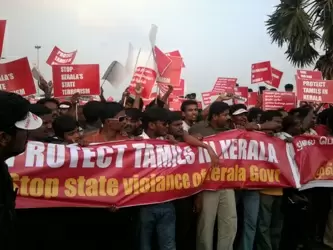 |
|
Protests in Tamil Nadu condemned the attacks against Tamils in Kerala over the Mullaiperiyar issue
|
When the committee had to decide on the border between Uttar Pradesh and Bihar, Justice Fazal Ali recused himself as he was from one of the states. But when it came to deciding the Kerala border, Panikkar did not follow the principle but mobilized support in getting some of the Tamil majority areas annexed with Kerala.
Though questions were raised then – particularly by Prime Minister Jawaharlal Nehru and Tamil leader M P Sivagnanam, popularly called Ma Po Si - he continued to work as a member of the committee. Hence, the report of the committee can be challenged and the stain of bias cannot be removed from it by
citing the passage of time.
In the final report, of the 9 taluks in Travancore-Kochin state that the Travancore Congress Party wanted to be annexed with the Madras state, only five names figured. The Travancore Congress Party was fighting for the annexure of the nine taluks that were identified to have a majority Tamil speaking population. However, the Madras state was denied the four taluks, namely Neiyatrinkarai South, Nedumankadu East, Devikulam and Peermedu.
Subsequently, Devikulam – Peermedu taluks, where the Mullaiperiyar dam and reservoir are located, was made into one constituency in the Travancore – Kochin state legislative assembly.
In the first election after independence, the Travancore Tamil Congress party fielded a candidate by name S S Sharma, who was a Tamil Trade Union Leader. Sharma won the polls, which was an indication of the people's overwhelming desire to merge their area with the state of Madras.
In the Travancore – Kochin state legislative assembly, Sharma vehemently argued for the merger of these two taluks with the state of Madras by stating that the Tamils constituted more than the majority in the area and that only due to their hard work the area was flourishing.
Even now, Tamils are a majority in the area. The Deputy Superintendent of Police (SB-CID) of Idukki district had sent a report dated 17.11.2006 to the ADGP that growing Tamil population in Idukki district can be a threat to Kerala’s territorial integrity and that it could lose Devikulam and Peermedu taluks to Tamil Nadu and recommended strict measures to control issuance of voter ID cards and ration cards to Tamils.
So, it is only logical and legitimate for the people of Tamil Nadu to now seek redressal for an injustice committed to them during the reorganisation of states by demanding the accession of Peermedu, Devikulam and Udumbanchola - which was subsequently carved out of Peermedu and Devikulam taluks.
Note: Several facts and details for the above article were sourced from the book, “Thiruvithankoor Thamizhar Poratta Varalaru” (The history of struggle of Travancore Tamils) by Prof Dr P Yokeeswaran, first edition, Neela Publications)
The author is a Madurai based advocate
AN APPEAL TO OUR READERS: Please maintain decency in your language while posting comments. Vulgar/ abusive comments and those making personal attacks will be deleted. Thanks.
Also Read
‘Water for Tamil Nadu, Safety for Kerala’ does not hold water in Neyyar issue












